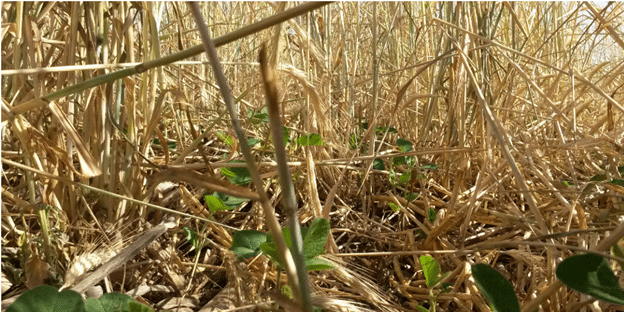MCCC-134
This publication is intended to provide a starting point for farmers who are new to growing cover crops. With experience, farmers may fine-tune the use of cover crops for their systems.
Introduction
With much attention focused on soil health and crop diversity, interest in cover crops has increased greatly in recent times. Generally, following small grains (after harvest or early season hay crop), a wide range of cover crop species can be selected due to an ample seasonal window for establishment and growth. However, for the row-crop growers who practice a strict corn-soybean rotation, the species selection is limited. Winter rye (cereal rye, Secale cereale L.) has been a go-to cover crop choice among many row-crop growers in the Midwest, including in South Dakota. Some producers have also used winter wheat and/or winter triticale as a cover crop. One of the most important attributes that winter rye possesses over other winter cereals such as winter wheat or triticale is its tolerance to extreme cold temperatures. Further, its rapid early spring growth and allelopathic characteristics, which allow it to suppress tough weeds, have also been favored by producers.
Planning and Preparation
- Planning—Having a clear objective on why the cover crop is being used is critical as preparation can vary for different uses. For example, depending on the farm situation, cereal rye can also be used for supplemental forage in the spring. Consulting university Extension and NRCS staff, and fellow producers who have been in this practice longer can be of great help. If you are new to the practice, starting small and gradually increasing acres over the years is suggested.
- Rotation—Planting rye after corn and ahead of soybean is a better fit than after soybean and before corn because soybeans can tolerate later planting in the spring better than corn. This allows rye to accumulate more spring biomass. Studies conducted in southeastern South Dakota have shown no negative impact on soybean yields when planted in late May to the first week of June in fields with preceding rye cover crops. However, in years with below-average precipitation, terminate rye early in the spring so that soil moisture can be preserved for the following soybean crop. The sequence of winter rye within the cropping rotation is crucial for maintaining the agronomic performance of cash crops. When planted after soybean and terminated close to corn planting, rye has shown negative effects on corn yields in South Dakota. However, when rye was terminated at least two weeks prior to planting corn, most of those detrimental effects were negated. More studies are needed to examine the true effects of a rye cover crop on a subsequent corn crop. Growing a cereal grain crop after a cereal rye cover crop is not suggested due to weed control issues and possible contamination of the cereal grain crop.
- Corn maturity—Do not plant earlier-maturing corn hybrids in an effort to establish rye earlier in the fall. Planting recommended-maturity hybrids maintains the optimal performance of the corn crop and produces higher yields that outweigh any rye biomass gain in the spring.
- Residual herbicides—Herbicides with a longer residual period can have a significant impact on cover crop establishment and growth. However, cereal rye planted in the fall has shown good tolerance to common herbicides used on corn. Keep in mind the grazing restriction of herbicides used if cereal rye is to be grazed in the winter or the following spring.
- Seed source—Quality seeds produce quality plants. Acquiring seeds of a known variety from a reliable source increases the chances of better growth and performance. Variety not stated (VNS) seeds are less expensive but can have inferior growth.
Fall Work
- Broadcast-seeding rye into corn—Cereal rye is broadcast-planted into standing corn from late August to the first half of September, or when corn starts to open up the canopy (R5, dent stage, to R6, physiological maturity). Usually an airplane or high-clearance seeder is used for broadcast seeding. Planting when rain is in the forecast is ideal for good early growth and establishment.
- Planting after corn harvest—In addition to broadcast-seeding, some producers in South Dakota also choose to drill cereal rye immediately after corn harvest (silage and/or grain). Drilling allows for better seed-to-soil contact, resulting in a uniform stand. Although fall plant growth can be somewhat limited after grain harvest, the stand in the spring is more uniform when compared to broadcast-seeding. Biomass for both seeding types are comparable when broadcast-seeded fields receive precipitation immediately after seeding. In other cases, rye in drill-seeded fields can yield up to 30% more biomass in the spring.
- Seeding rate—For ground cover, 40 lbs./acre (bulk seeding rate) is a suggested in South Dakota. A higher seeding rate in the range of 60–70 lbs./acre can be used for weed suppression.
- Tillage—Soybeans are usually no-till planted into growing rye in the spring, which is a green planting. Tillage can take away any benefit a cover crop has provided to the health of the soil. Cover crops and no-till usually go hand-in-hand.

Spring Work
- Soil moisture—Cereal rye growth in the spring is usually good even when the previous fall was dry. If the winter and spring are dry and the spring weather forecast does not call for potential precipitation, spraying the rye by late April or early May is required. In South Dakota, rye grows rapidly in May and can use up already depleted soil moisture. In conditions with good soil moisture, rye can be allowed to grow until normal soybean planting time.
- Termination timing—When soil moisture is adequate, the effects of termination timing of cereal rye on soybean yields has been minimal. Lower yields on soybean have usually been associated with lower soil moisture rather than termination timing. Soybean is usually planted into green rye, with the rye terminated by chemical spray at the time of soybean planting. Details on cover crop termination can be found in NRCS Cover Crop Termination Guidelines: Non-Irrigated Cropland (see Resources).
- Herbicides—A full rate of glyphosate is the most common method used to terminate rye in the spring. Herbicide efficacy improves if sprayed when rye is actively growing and on a warm sunny day (>60°F). When sprayed well ahead of planting soybean, a broadleaf herbicide such as 2,4-D can also be tank-mixed as a general burndown mix.
- Soybean planting—It is best to no-till plant soybean into either green rye (terminated at the time of planting) or dead residue (terminated about 10 days prior to planting). Check planting depth and seed furrow closure shortly after beginning in case any planter adjustments are needed. Although not suggested in South Dakota, if corn needs to be planted on fields with rye cover crop due to unusual circumstances, it is best to terminate rye at least 14 days prior to planting corn.

Resources
Cover Crop Selector Tool—available from the Midwest Cover Crops Council, www.midwestcovercrops.org
Thinking Cover Crops? Winter Rye Between Corn and Soybean (South Dakota State University Extension website)
Management Implications of a Rye Cover Crop on Nutrient Cycling and Soybean Production in Southeast South Dakota: Focus on Rye Seeding Rates and Termination Timing (South Dakota State University thesis)
NRCS Cover Crop Termination Guidelines: Non-Irrigated Cropland (USDA-NRCS)
Author
David Karki, South Dakota State University Extension
(Note: This publication was adapted with consent from MCCC under a joint project to produce customized introductory guidance about cover crops for all member states/provinces.)
Reviewers and Contributors
Eric Barsness, USDA-NRCS; Anthony Bly, South Dakota State University Extension; Eileen Kladivko, Purdue University; Anna Morrow, Midwest Cover Crops Council
The Midwest Cover Crops Council (www.midwestcovercrops.org) aims to facilitate widespread adoption of cover crops throughout the Midwest by providing educational/outreach resources and programs, conducting new research, and communicating about cover crops to the public.
Funding for this project was provided by McKnight Foundation.
December 2022
The U.S. Department of Agriculture (USDA) prohibits discrimination in all its programs and activities on the basis of race, color, national origin, age, disability, and where applicable, sex, marital status, familial status, parental status, religion, sexual orientation, genetic information, political beliefs, reprisal, or because all or a part of an individual’s income is derived from any public assistance program. (Not all prohibited bases apply to all programs.) Persons with disabilities who require alternative means for communication of program information (Braille, large print, audiotape, etc.) should contact USDA’s TARGET Center at (202) 720-2600 (voice and TDD). To file a complaint of discrimination write to USDA, Director, Office of Civil Rights, 1400 Independence Avenue, S.W., Washington, D.C. 20250-9410 or call (800) 795-3272 (voice) or (202) 720-6382 (TDD). USDA is an equal opportunity provider and employer. ©2022 by MCCC. All rights reserved.
